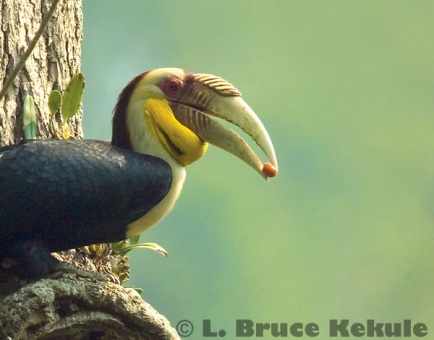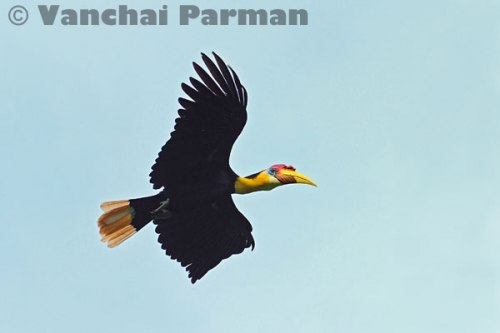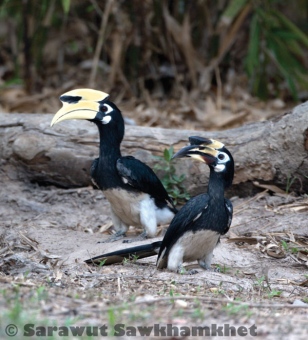Posts Tagged ‘birds’
Vultures in India…important birds for the habitat…!
While I was on safari in April 2016, I was lucky to get some nice vulture shots on a carcass at Corbett Tiger Reserve and then at a cliff-face in Panna Tiger Reserve.
Himalayan Griffon , Red headed and Cinereous vultures plus a crow on a carcass in the Dikhala grassland in Corbett Tiger Reserve…!
A Himalayan Griffon vulture flying into a spotted deer carcass…!
Long-billed vultures an a cliff-face in Panna Tiger Reserve…!
A vulture on the wing in mid-morning in Panna Tiger Reserve…!
Hornbills: Indicator species of an intact ecosystem
WILD SPECIES REPORT
Majestic birds and living fossils
Wreathed hornbill in Kaeng Krachan National Park
Most people are familiar with the hornbill, nature’s amazing avian fauna with large bills and a casque, and some with raucous calls. They also have strange but interesting nesting habits and the larger hornbills make a loud whooshing noise when flying sounding much like a locomotive, and heard from quite a distance. In any given forest, if they thrive it means the ecosystem is fairly intact.
Brown hornbill at a ground nest hole in Huai Kha Khaeng
The hornbill belongs to an ancient family (Bucerotidae) of birds seen in fossils from the strata of the ‘Eocene’ period of Europe some 50 million years ago. Through tectonic-plate movement, hornbills however have become restricted to tropical Africa and Asia, and there are 55 species found in the world with 24 in Africa and the rest surviving in the forests of South and Southeast Asia. Thailand has twelve species recorded throughout the country, and all still thrive but some are endangered.
Wreathed hornbill with fruit for his mate in the nest
These noisy, social, omnivorous birds need large tropical forest areas with many fruiting trees throughout the year to survive. Giant emergent trees with nesting cavities are also important to carry on their legacy but some species nest near the ground. The diet of the hornbill is a preponderance of figs and other fruits but also take animal food such as snakes, lizards and small bird hatchling needed for dietary protein when rearing the chicks.
About six years ago, my dream to photograph hornbills at a nest became a reality. The month is May and I’m sitting in a hot, humid blind in the dry evergreen forest of Kaeng Krachan National Park. The location is near the 9th tier of Thor Thip waterfall about 10 kilometers from Phanern Thung ranger station in the interior of the protected area.
Great hornbills flying off a fig tree
A pair of wreathed hornbills was sighted coming and going from a nest-hole by a forest tour guide, and relayed to my close friend Suthad Sappu who has been a ranger with the park for more than 15 years, who informed me and I made immediate plans to make a visit. It took me a few days to get going and I finally loaded up my old 4X4 pickup truck making my way out of Bangkok to Phetchaburi province in southwest Thailand, a three-hour ride.
We eventually arrived at the end of the road at Kilometer 36 and immediately got ready for the 4-plus kilometer walk downhill to the waterfall along a well-established nature trail. On a hill across from a tall tree with a large hole in it, I quickly set-up a blind and went into hiding.
Rufous-necked hornbill in Mae Wong National Park
A pair of wreathed hornbills chose this cavity for their nest. By the time I got there, the female was already inside and the front had been closed-in with droppings. This chore is taken care of by the female so that just a small slit is left. The perch above the hole is just right to allow the male to feed the occupants with fruit and small animal morsels.
In a short while, a loud whooshing noise was heard and the male hornbill arrived as the morning light glowed. The large bird popped out fruit and gingerly fed the female. It was a beautiful experience seeing and photographing this great natural spectacle. After filling my card with digital images, I waited until the bird left on another fruit gathering mission and then left quietly. As always, this sighting is etched in the old memory bank.
Wrinkled hornbill in Hala-Bala Wildlife Sanctuary
The chicks eventually hatched and the cycle of life began for yet another group of hornbills. The female finally emerged and left the young ones in the nest for a while longer as the adults continued to feed them. One day, they eventually outgrew the nest and broke free. It is one of the greatest success stories of the natural world.
Hornbills unfortunately have been persecuted for their large bill and casque as an ornament. Poachers for subsidence also eat these large birds. This has greatly impacted all species of hornbill throughout the Kingdom but there are still many protected areas where they can be found. Many are near extinction at the hands of man in his quest to survive with the destructive forces of encroachment and poaching.
White-crowned hornbill in Hala-Bala
In 1996, Japanese photographer Atsuso Tsuji published an excellent book in conjunction with Sarakadee Press entitled ‘Hornbills – Masters of Tropical Forests’ about these amazing creatures. This tome is now out of print but probably can be found in some used bookstores. With many photographs and text, he delves into the lives of hornbills in Khao Yai National Park. There are chapters on nesting, roosting and feeding habits, and in particular the entire life cycle of hornbills.
A story about hornbills in Thailand would not be complete without mentioning biologist Dr Pilai Poonswad with Mahidol University who has dedicated her life to the study and research of this magnificent avian fauna, and she has also published a scientific journal concerning the subject. Her work has included helping hornbills to choose nest holes by installing a ledge just below the cavity to allow these large birds to perch easily while feeding the female and chicks inside.
Great hornbill in Khao Yai National Park
I was very fortunate to photograph a great hornbill male in Khao Yai while it visited a nest very close to the main road in the park shown in the story. Ajarn Pilai and her team has also worked in other protected areas like Huai Kha Khaeng, Hala Bala and Khlong Saeng wildlife sanctuaries, and Keang Krachan and Khao Sok national parks plus many others throughout Thailand to monitor these birds, and she has established the Hornbill Research Foundation to further the study and protection of these majestic animals.
Down south in Surat Thani in the rich forests of Khlong Saeng next to Khao Sok, I did a camera trap survey deep in the interior catching many animals including a white-crowned hornbill down on the ground next to a large waterhole shown in the story. I also photographed a brown hornbill at a nest hole on the ground in Huai Kha Khaeng.
Oriental pied hornbills in Kaeng Krachan
My close friend Sarawut Sawkhamkhet photographed a pair of Oriental pied hornbills at a waterhole in Kaeng Krachan. Another fellow wildlife photographer Saman Khunkwamdee photographed helmeted and rhinoceros hornbills many years ago down in Hala-Bala Wildlife Sanctuary during peacetime in Southern Thailand on the border with Malaysia. Another close friend Vanchai …….a has photographed all 12 species, quite a feat and just recently visited Hala-Bala capturing the very rare wrinkled hornbill and others in the sensitive south.
The future of the hornbill in Thailand is the same for all species that inhibit pristine forests; they must be protected at all costs from destruction by encroachment and poaching. This responsibility rests with the Department of National Parks, Wildlife and Plant Conservation, and it is imperative that the management, protection and enforcement is greatly improved so that the magnificent protected areas remain intact. The government and private sector should work together to insure hornbills and all the other creatures and ecosystems remain part of Thailand’s amazing natural heritage.
Oriental pied hornbill with fruit for its mate
According to the very informative ‘Birds of Thailand’ by Boonsong and Round, there are 12 species of hornbill found in Thailand as follows:
1) White-crowned hornbill (Berenicornis comatus) with a bushy white crest and blackish bill and a small casque. Habitat is evergreen forests from foothills to 1000 meters, and is an uncommon resident.
2) Brown hornbill (Plilolaemus tickelli) is relatively small in size and brown plumage with white orbital skin and yellowish bill and small casque. Found occasionally in mixed deciduous forest adjacent to evergreen forest up to 1,500 meters. They are an uncommon resident.
3) Bushy-crested hornbill (Anorrhinus galeritus) has mainly black plumage with a small casque and a thick, drooping crest and pale blueish gular and orbital skin. Found in evergreen forest from the plains to 1,000 meter. They are fairly common resident.
4) Rufous-necked hornbill (Aceros nipalensis) is identified by a combination of bright blue orbital skin and bright orange-red gular pouch, and yellowish ivory bill with no casque. Found in evergreen and hill evergreen from 600 meters to 1,800 meters, and is a rare resident.
5) Wrinkled hornbill (Rhyticeros corrugatus) has all black wings and is distinguished from wreathed hornbill by smaller size. Yellowish bill and small reddish casque. White gular pouch in males and blue gular pouch in males. Found in lowland evergreen forest in the South. Rare with just a few left in Southern Thailand due to habitat destruction.
6) Wreathed hornbill (Rhyticeros undulates) shows all black wings with a white tail, and black bar on gular pouch that is yellow in males and blue in females. Diagnostic corrugations on sides of both upper and lower mandibles. Found in evergreen and mixed deciduous forests from the plains to 1,800 meters. They are an uncommon to locally common resident.
7) Plain-pouched hornbill (Rhyticeros subruficollis) in coloring is similar to the wreathed hornbill but distinguished by slightly smaller size. Lacks corrugations on sides of bill. Found in evergreen and mixed deciduous forests of the lowland and lower hills. They are a rare resident.
8) Black hornbill (Anthracoceros malayanus) is small in size with all black plumage with white tips on tail feathers. The bill is yellowish white in the male and blackish on the female and both with a whitish cassque in both sexes. They are found in evergreen forests in the plains and foothills, and are a rare resident.
9) Oriental pied hornbill (Anthracoceros albirostris) is identified by its small size, whitish face patches, white lower breast and belly. The bill and casque is ivory-colored and marked with black with casque larger in males but more heavily marked blackish in females. Can be found in evergreen and mixed deciduous forests and secondary growth from the plains up to 1,400 meters, and is a fairly common resident.
10) Rhinoceros hornbill (Becerous rhinoceros) is very large and mainly black with a white belly and tail marked with broad black band. Large upturned casque is reddish and bill yellow, and is lighter in color on the female. They are found in the extreme south of Thailand in evergreen forests from lowlands up to 1,200 meters, and are a rare resident.
11) Great hornbill (Becerous bicornis) is very large and is easily recognized by golden-stained white wing bar and white trailing edge to wing and by white tail with black band. Red eye in males and white eye in females. Mainly with a yellow bill and casque. They are found in evergreen and mixed deciduous forest from plains up to 1,500 meters and found on some offshore islands. Uncommon to locally common residents.
12) Helmeted hornbill (Rhinoplax vigil) is large with a elongated central tail feathers. Blackish brown with a white belly. Short conical bill and rounded casque is red. They are found in evergreen forests from plains up to 1,200 meters and is, an uncommon to rare resident.















